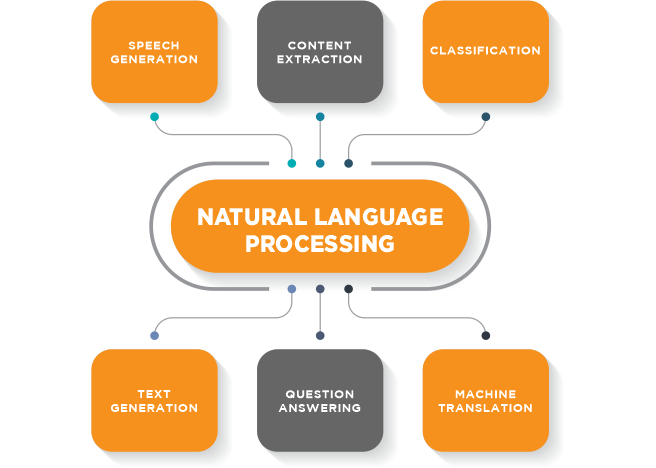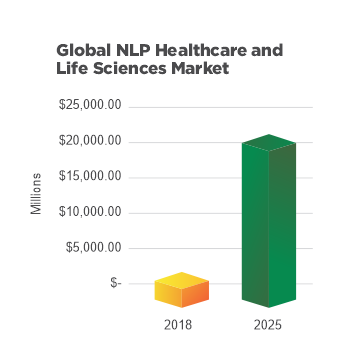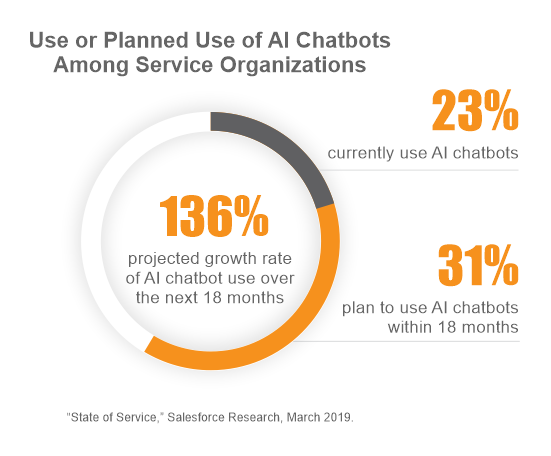Introduction
Some of the most ground-breaking capabilities of Artificial Intelligence (AI) include listening, speaking, writing, and understanding human language. Natural Language Processing (NLP) is a subset of AI that extracts meaning from human language. It focuses on content extraction, classification, machine translation, question answering, and text or speech generation. It is predominantly used for text mining, augmenting workflows, assisting in inquiry answering, and machine translation for recurring tasks.
Natural Language Processing:
-
Enables systems to classify and process written and spoken text. It also allows communication with humans either by reading, understanding, and writing text, or by hearing, understanding, and generating speech.
-
Includes techniques aimed at parsing, interpreting, and generating language.
-
Deals with speech recognition, semantics, and other grammatical aspects of natural languages.
-
Used to extract, classify, and summarize unstructured text, converting it to structured data.

Exponential Growth and the Core Benefit of NLP

The top categories for NLP-related patents in the last three years relate to cognition, creating structured databases from unstructured data, and domain-specific data analyses (i.e., healthcare).
There have been 3,700 NLP-related patent applications filed in the last 10 years; over 82% were filed in the last five years, highlighting the rapid pace of new intellectual property. By 2023, 50% of health delivery organizations will have deployed NLP technologies. 1
Consumer acceptance of digital advancements in the healthcare industry, along with active demand for improved medical services, are expected to drive the market for NLP in healthcare and life sciences. The global use of NLP in these markets accounted for US $1.5B in 2018 and is projected to exhibit a Compound Annual Growth Rate of 26.8% over the forecast period (2018 – 2026) with growth to $21.3B by 2026.2
It is estimated that 70% to 80% of the information in the Electronic Health Record is in an unstructured, free text or natural language format. One of the core benefits of NLP for healthcare providers is turning unstructured data into intelligence for use in predictive and prescriptive AI models.3
Applying NLP within Healthcare Technology Operations
In healthcare technology, there are four key areas of focus and application for NLP:
- Patient Care and Outcomes
- Clinician Experience
- Efficiency
- Consumer Engagement
The analysis of unstructured, free-form text cuts across all four of these key areas.
The Clinical Documentation process benefits from NLP through algorithmic automation of key findings and summarizations, offering real-time physician documentation improvements. NLP applies conversion and classification techniques for computer assisted clinical documentation improvement through real-time translation factors and acting as a digital scribe. NLP aids in quality measure improvements within care delivery, advancing value-based care by pulling the relevant information together for the clinician.
NLP is used in population health clinical decision support by providing easily accessible information at the point of care and time in which it is needed. NLP also provides digital speech analysis for clinical diagnoses, appropriately translating and storing the right information in the Electronic Medical Record for use across the care continuum.
NLP is commonly applied to workflow management for computer assisted coding, augmenting the process and helping the coder make the best decisions. In research and design applications, NLP is used to automate patient screening for clinical trials and review of real-world evidence. Another consumer application for NLP includes consumer health literacy within the patient portal process, which can help patients gain insight into their medical records and clinician notes.
The intention is to better engage patients with more information about their health. Still, these tools fall short when patients are overwhelmed with medical jargon they do not necessarily understand. NLP algorithms identify complex medical terms and translate them into everyday language the patient can easily understand, which leads to more meaningful conversations with their clinician and ultimately, better health outcomes.
Chat-Bots and Deep Learning Models
NLP also acts as a virtual health assistant in a chat-bot scenario where financial, time, and resource constraints have led to a shortage of availability for in-person services. The initial bot can collect data and customer information, disseminate answers to Frequently Asked Questions, provide customer support tips and hours of operations, diagnose minor problems, and triage as appropriate to skilled personnel.
In May 2018, Google AI collaborated with Stanford Medicine, UC San Francisco, and University of Chicago Medicine to integrate Machine Learning in Electronic Health Records (EHR). The goal was to achieve accurate and scalable results, along with developing a pipeline for data processing to transform EHR files in a standardized format (FHIR).
The team used a deep learning approach that incorporated the entire EHR. This included NLP transformed free-text notes which produced predictions for a wide range of clinical problems and outcomes and outperformed traditional, clinically used predictive models. Using the entirety of a patient’s chart for every prediction did more than promote scalability; it exposed more data to make accurate predictions. For predictions made at discharge, the Google AI deep learning model considered more than 46 billion pieces of EHR data and achieved more accurate predictions earlier in the hospital stay, than did traditional models. The use of NLP to translate and embed free text within the deep learning model for prediction helped train the model which led to better outcomes. 4

Clinicians have historically distrusted these models because they were a “black box” prediction algorithm. There was no clear understanding of how the conclusions were drawn. However, within the context of the Google AI study, the team demonstrated how the method they used “opened up the box” allowing clinicians to visualize what data the model used for each patient, letting them determine if a prediction was based on a credible fact and guiding them to the best course of action.
Conclusion
Your organization can benefit from Natural Language Processing solutions. Vee Healthtek can help you succeed, whether it is a simple chat-bot or integrating NLP across the care continuum to reduce operational expenses and improve patient care and outcomes.
Vee Healthtek can help enable your NLP aspirations!

References:
Source 1: Emerging Technologies: Natural Language Processing Patent Growth Insights Published 3 June 2020 - ID G00722897 Annette Jump
Source 2: (https://www.coherentmarketinsights.com/market-insight/natural-language-processing-nlp-in-healthcare-and-life-sciences-market-2798)
Source 3: Kho AN, Rasmussen LV, Connolly JJ, et al. Practical challenges in integrating genomic data into the electronic health record. BMJ 2013; 15 (10): 772–8.
Source 4: https://www.nature.com/articles/s41746-018-0029-1
